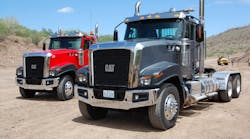Amid a continuing corporate restructuring, Caterpillar announced today that it will cease production of its on-highway vocational CT truck line. Cat said about 70 jobs would be affected by the decision.
“Remaining a viable competitor in this market would require significant additional investment to develop and launch a complete portfolio of trucks, and upon an updated review, we determined there was not a sufficient market opportunity to justify the investment,” said Ramin Younessi, vice president with responsibility for Caterpillar’s Industrial Power Systems Division. “We have not yet started truck production in Victoria, and this decision allows us to exit this business before the transition occurs.”
The company’s vocational truck line includes the CT681, CT660 and CT680. Launched in 2011, the line was initially built by Navistar. Last year, Cat announced it would begin production of the trucks itself in Victoria, Texas.
Looking back at Cat Trucks:
Photos: Caterpillar’s CT660 vocational truck
Article: Caterpillar to build trucks on its own
Article: Caterpillar unveils new CT680 model
Photos: Test driving the new CT680
Caterpillar said after evaluating the “current business climate in the truck industry and a thorough evaluation of the business, the company decided it would withdraw from this market.”
Cat initially struck a deal in 2009 with Navistar to build a vocational truck line, launching the CT660 in 2011, based on Navistar’s PayStar chassis. Navistar discontinued that model this year, replacing it with the HX Series.
The first CT660s rolling off the production line were offered with either a 10.5L C11 engine or a 12.L C13, both based on Navistar MaxxForce engines. A set-forward axle configuration, dubbed the CT681, was added to the line in was introduced in 2014.
The CT680 model was expected to further expand Cat’s presence with a 15L engine option and tractor configuration.
Last year, when Caterpillar announced it would produce its own trucks and engines, the company noted how critical the vocational truck line was to the business.
“The on-highway vocational truck product family is important to our product line; customers like our trucks and want to include them in their fleets in a variety of heavy duty applications such as dump trucks, mixers, haulers or one of the other configurations we offer,” noted Chris Chadwick, director of the Caterpillar’s global on-highway truck group, said in a statement at the time. “Our updated strategy reaffirms our commitment to grow and develop our presence in the vocational truck industry moving forward.”
However, despite having a potential built-in customer base due to its heavy construction equipment business, the trucks never gained significant market share in the U.S. The Wall Street Journal, in 2015, noted that Cat sold only around 1,000 vocational trucks annually.
The company also used to make on-highway engines, but abandoned that market before the 2010 EPA emissions standards went into effect.
A global restructuring has been ongoing at the company with more than 20,000 positions being eliminated worldwide. Some analysts, though, believe even more job cuts could be coming as Caterpillar tries to position itself for future growth.
At the time of the truck line’s initial launch, Caterpillar had high hopes for the vehicles, hoping to crack the top two in vocational truck sales within five years. Five years later, that dream has ended.



